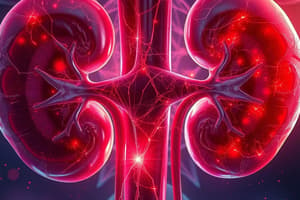Podcast
Questions and Answers
What anatomical feature distinguishes the positioning of the kidneys?
What anatomical feature distinguishes the positioning of the kidneys?
- Both kidneys are at the same height.
- The kidneys are located anterior to the peritoneum.
- The left kidney is typically lower than the right.
- The left kidney is higher than the right. (correct)
Which vital signs might indicate potential renal dysfunction?
Which vital signs might indicate potential renal dysfunction?
- Elevated respiratory rate and clear urine output.
- Fluctuations in blood pressure and weight changes. (correct)
- Increased weight and stable mental status.
- Consistent heart rate and normal body temperature.
Which of the following is NOT one of the four techniques used in physical examination?
Which of the following is NOT one of the four techniques used in physical examination?
- Palpation
- Inspection
- Diagnosis (correct)
- Auscultation
During a health assessment, what is the expected finding when palpating the bladder?
During a health assessment, what is the expected finding when palpating the bladder?
Which chronic disease could have an impact on the urinary system?
Which chronic disease could have an impact on the urinary system?
What is the correct sequence for conducting a physical health examination of the urinary system?
What is the correct sequence for conducting a physical health examination of the urinary system?
What indicates incomplete bladder emptying when assessed by percussion?
What indicates incomplete bladder emptying when assessed by percussion?
How often do peristaltic contractions of the ureter occur?
How often do peristaltic contractions of the ureter occur?
What is the optimal position for a prostate examination?
What is the optimal position for a prostate examination?
What should the prostate gland feel like upon palpation?
What should the prostate gland feel like upon palpation?
What is the primary function of the testicles?
What is the primary function of the testicles?
What areas should be inspected for skin condition before a prostate exam?
What areas should be inspected for skin condition before a prostate exam?
What is the primary function of the renal pelvis in the genitourinary system?
What is the primary function of the renal pelvis in the genitourinary system?
What is a recommended method to help a patient relax during a prostate examination?
What is a recommended method to help a patient relax during a prostate examination?
Which of the following factors can influence urination?
Which of the following factors can influence urination?
Which procedure is primarily used to assess urinary bladder fullness?
Which procedure is primarily used to assess urinary bladder fullness?
What is the correct sequence of urine formation?
What is the correct sequence of urine formation?
During which inspection technique should the patient lie in a supine position?
During which inspection technique should the patient lie in a supine position?
What does the urethra primarily do in the genitourinary system?
What does the urethra primarily do in the genitourinary system?
What does the process of glomerular filtration involve?
What does the process of glomerular filtration involve?
What is a significant indicator when inspecting the abdomen during kidney examination?
What is a significant indicator when inspecting the abdomen during kidney examination?
Which of the following best describes the term 'peristaltic contractions' in relation to the ureters?
Which of the following best describes the term 'peristaltic contractions' in relation to the ureters?
Flashcards are hidden until you start studying
Study Notes
Alcohol and Smoking Assessment
- Assess alcohol consumption: frequency, quantity, and date of last drink.
- Evaluate smoking history: duration, quantity, and efforts towards cessation.
Urology Terminology
- Understand factors influencing urination: sociocultural, psychological, muscle tone, fluid balance, surgical procedures, and medication.
Functions of the Genitourinary System
- Renal Pelvis: Receives urine from the kidneys.
- Ureters: Transport urine to the bladder via peristalsis (1-5 times/minute).
- Bladder: Muscular container for urine.
- External Meatus: Urine and sperm exit in males.
- Aorta: Supplies blood to renal arteries.
- Urethra: Carries urine from bladder to outside.
Urine Formation Process
- Glomerular Filtration: Initial filtration of blood.
- Selective Reabsorption: Re-absorption of necessary substances.
- Excretion: Removal of waste products.
Polycystic Kidney Disease
- A genetic disorder causing cyst formation in kidneys.
Abdomen Inspection Protocol
- Inspect abdomen while patient is supine: look for symmetry, smoothness, and avoid lesions or discolorations.
- Kidney Palpation:
- Patient lies supine; observe right kidney position.
- Use hands to palpate kidneys during deep inhalation; normally not palpable unless enlarged or in thin individuals.
Anatomical Structure of Kidneys
- Located retroperitoneally, with the left kidney higher than the right due to liver position.
Physical Examination Techniques
- Inspection, palpation, percussion, and auscultation used during examination.
- Expected findings should be verbally communicated and documented accurately.
Renal Failure Considerations
- Important to understand implications of chronic diseases affecting the urinary system.
Bladder Percussion Technique
- Start at symphysis pubis, percussing upward towards the bladder; sound changes from tympanic to dull over the bladder.
- Dullness after voiding suggests incomplete bladder emptying.
Ureter Function
- Transports urine to the bladder via peristaltic contractions occurring 1-5 times per minute.
Prostate Gland Palpation Technique
- Position patient on left side, with knees flexed; inspect perineal and anal areas for abnormalities.
- Lubricate and insert a finger into the rectum to palpate the prostate, which should feel smooth and rubbery, about walnut-sized.
Testicular Self-Examination
- Testes produce sperm and testosterone; importance of monthly self-exams for early detection of abnormalities.
Studying That Suits You
Use AI to generate personalized quizzes and flashcards to suit your learning preferences.




